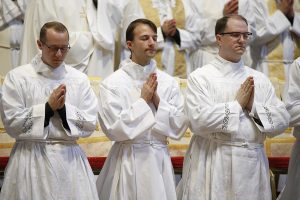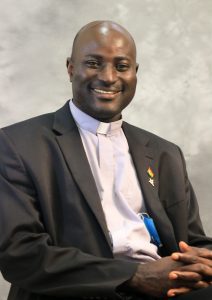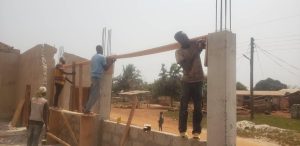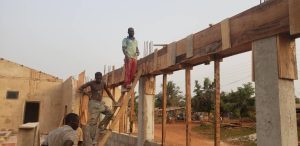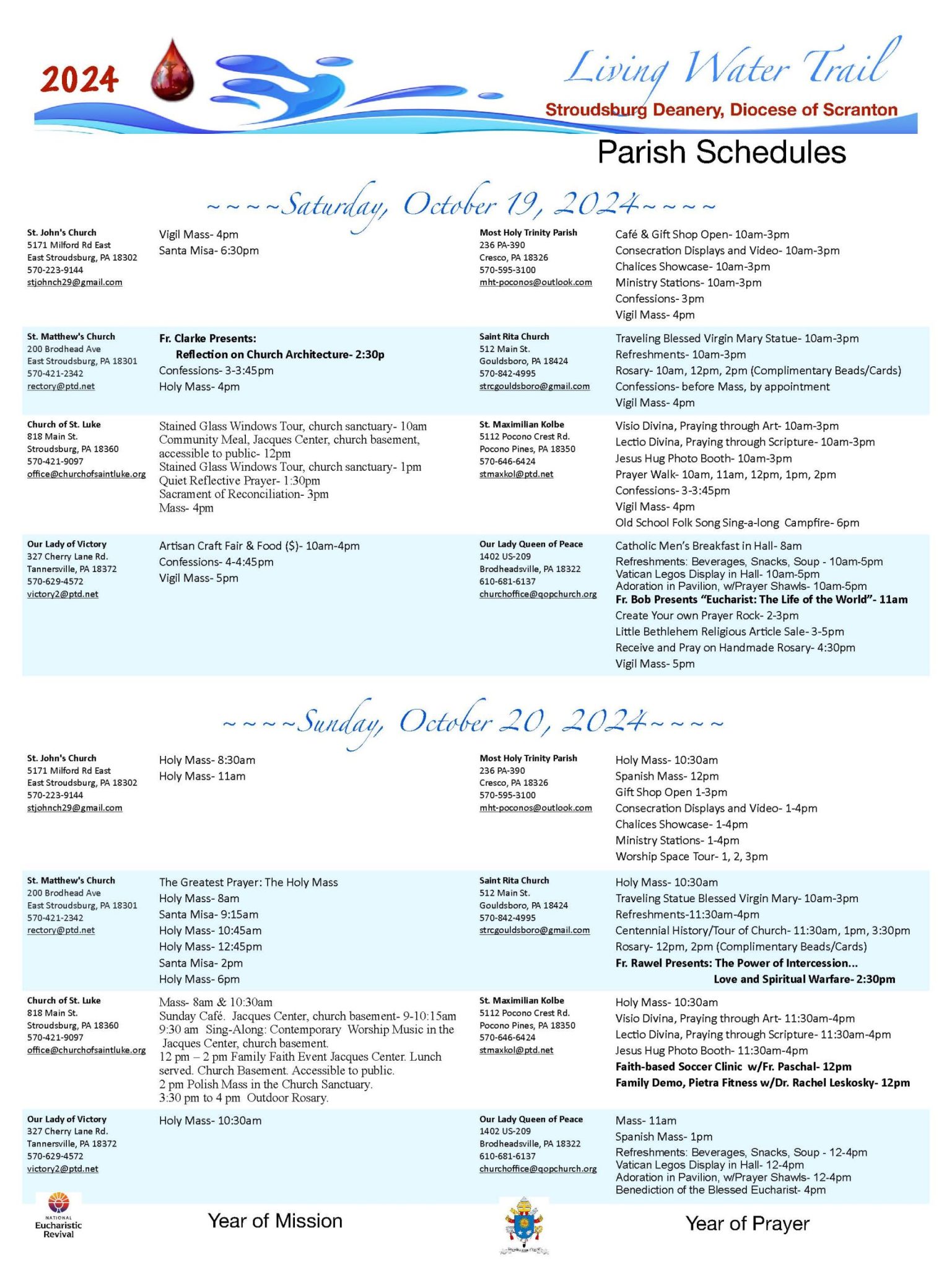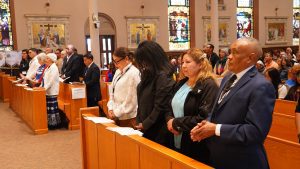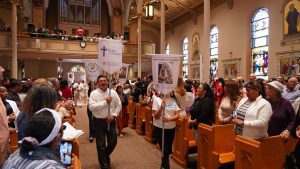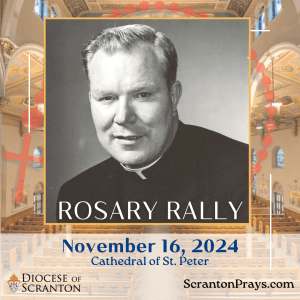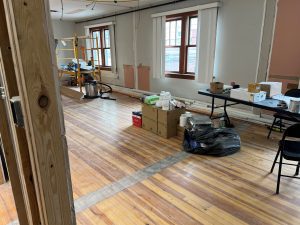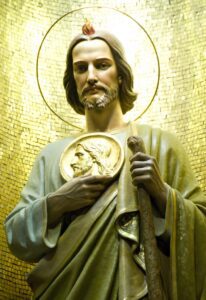NEW YORK (OSV News) – A remarkable day of faith and devotion unfolded at St. Patrick’s Cathedral in Midtown Manhattan Oct. 15 as thousands of Catholics gathered for a Eucharistic procession.
The event, sponsored by the California-based Napa Institute in collaboration with the Hallow prayer app, featured a Holy Hour, Mass, Eucharistic procession and veneration of a first-class of Blessed Carlo Acutis, offering participants a day filled with prayer. Organizers estimate some 3,500 people attended the fifth annual gathering.
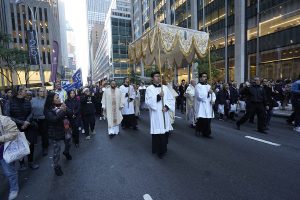
Sirius XM radio host Katie McGrady described the scene to OSV News, saying, “I was most touched by the diversity of the crowd gathered.” McGrady explained, “Wealthy business types alongside hourly employees, all walking behind Jesus together.”
The afternoon began with a Holy Hour and rosary led by New York Auxiliary Bishop Joseph A. Espaillat, known for his dynamic outreach to young Catholics. “We adore you, O Christ, and we praise you,” Bishop Espaillat began, praying in English and Spanish, kneeling before the Blessed Sacrament.
Leading a meditation on Psalm 69, Bishop Espaillat asked, “What are you passionate about?”
We are Christ’s passion, the bishop declared. “Jesus was, is and continues to be compassionate about his Father and his kingdom.” But, he continued, “I ask all of us today: Is Christ my passion?”
Bishop Espaillat urged his hearers to have the kind of passion for the Gospel that many fans demonstrate for their favorite teams, especially in the postseason. “People go crazy over this,” he said.
“When we spend time with Jesus in the Blessed Sacrament,” said Bishop Espaillat, “that means I need to be transformed, and being transformed means then that I go out and I am an alter Christus, another Christ, in this world that so desperately needs it.”
He challenged his hearers to oppose Proposition 1, the so-called Equal Rights Amendment on the ballot in New York state this November. “It is a lie,” Bishop Espaillat said. The amendment seeks to significantly broaden protections to cover sexual orientation, gender identity, gender expression and abortion access, including for minors.
“No one can preach quite like Bishop Joe,” McGrady said. He can at once tell a crowd to get over themselves and also recognize their influence in the same breath, she said. “He left all of us proud to stand up for our faith in the public square.”
The Mass, celebrated by Archbishop Paul S. Coakley of Oklahoma City, ecclesiastical adviser to the Napa Institute, was offered for peace in the Holy Land. The homilist was Msgr. James Shea, president of the University of Mary in Bismarck, North Dakota.
“We have an argument with God,” Msgr. Shea began. “The argument that we have with God starts with an argument that we have with ourselves within us: There is a conflict, a deep and bitter conflict between our deepest longings and our superficial fears.”
Msgr. Shea preached that our longing for the infinite is threatened by the fear that our deepest longing will not be fulfilled. “What will we do if we give him everything and it’s not true?” the priest prodded.
“We hedge the investment of our lives; we hold back,” Msgr. Shea said. “But what if we didn’t?” he asked. Citing the example of the Jesuit martyr St. Isaac Jogues, the first priest on Manhattan Island, Msgr. Shea urged the assembly to model the saint’s enthusiasm for evangelization and his love for the Eucharist.
“Christ in the Blessed Sacrament, the Lord here with us,” he said, “is the answer to all our prayers, all our hopes, sturdy, sure and true.”
Msgr. Shea concluded, “Now is the moment for us really to live the truth which we profess to hold back nothing at all, because, yes, we have an argument with God, but now is the time to put it to an end.”
Applause filled the cathedral as Msgr. Shea descended the pulpit stairs.
After Mass, the Eucharistic procession left through the front doors of St. Patrick’s Cathedral, heading to some of America’s busiest streets.
“It was amazing to see transit buses with TV ads and rush hour commuters grind to a halt as the monstrance came by, and while some kept walking, most stopped and stared, in awe, at both Jesus and the crowd,” McGrady shared.
The procession passed iconic New York sites, including Radio City Music Hall and Times Square.
Upon returning to St. Patrick’s Cathedral, the procession concluded with Benediction presided over by Cardinal Timothy M. Dolan, archbishop of New York, and veneration of a first-class relic of Blessed Carlo Acutis, known for his devotion to the holy Eucharist.
“Inside the cathedral, as Mass was ending, there was the beautiful chanting of hymns with a mix of silence as we prepared to start the Eucharistic procession,” Rosemary Sullivan, executive director of the National Conference of Diocesan Vocation Directors, told OSV News.
“The grand doors of St. Patrick’s opened and you could hear the harsh sounds of the city, which had no idea who was about to walk their streets,” she said.
“As Jesus stepped out onto Fifth Avenue and navigated his way through midtown, the people of New York took notice,” she continued. “Just regular people stopping, taking photos, asking questions, some seemingly frozen in place because they were moved by someone who they may not necessarily (have) understood is the king of peace and hope, our Lord and Savior Jesus Christ.
“And yet Christ was reaching their hearts just the same. I like to imagine that is how the original disciples felt when they walk with Jesus asking people to let him into their hearts, their lives.”

